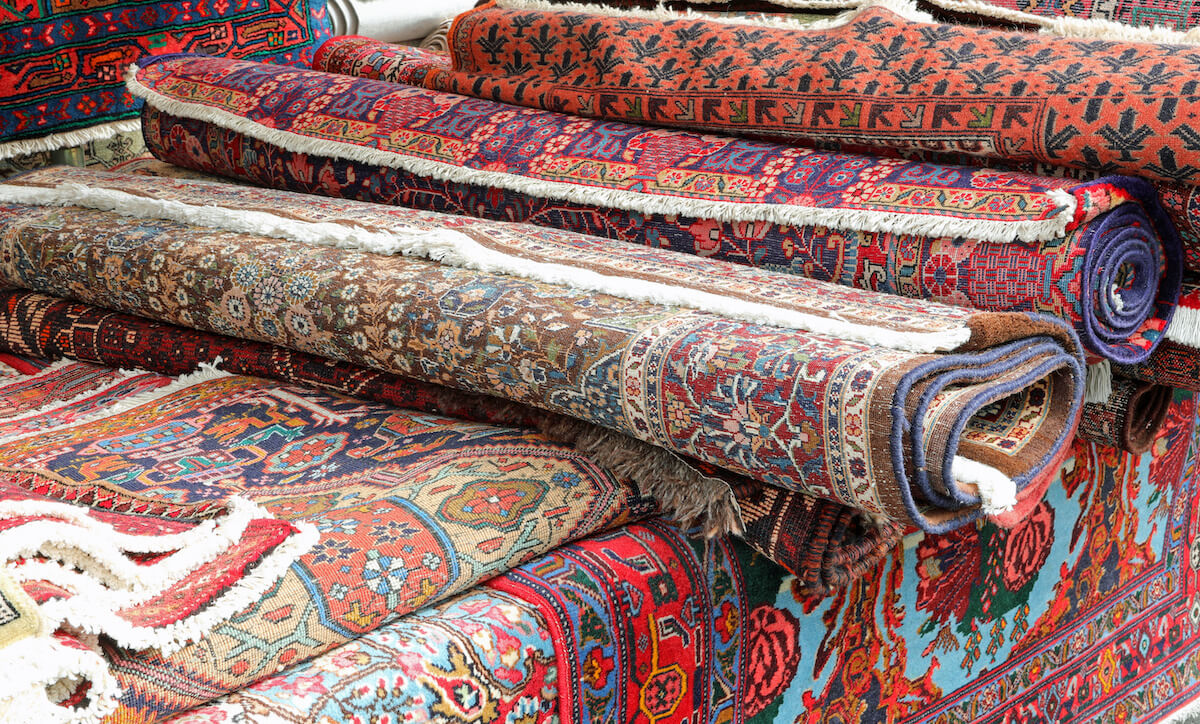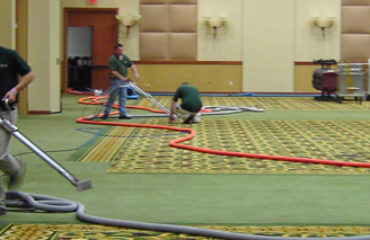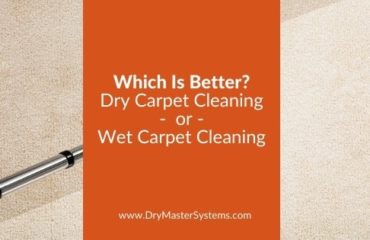Rugs come in different shapes, colors, and materials. They protect your floors from damage and add to your overall aesthetic. Rugs also help muffle sounds and keep your feet at a comfortable temperature.
Maintenance for your rugs differs depending on the material, where they are positioned in your home, and how much light and traffic they receive. If you treat your floor coverings well – cleaning up spills and rotating them every few months – you can expect your rugs to last a long time, bringing warmth and flair to your space.
General Daily and Weekly Maintenance
Regular cleaning is the best way to preserve your area rugs and maintain a healthy home. Create an upkeep checklist with daily and weekly tasks that include:
Spot Cleaning
In a busy household, accidents happen, from a glass of red wine spilled during a party to spaghetti sauce dripped on the rug at dinner. Cleaning the stain immediately is key to removing stains without damaging the color or fibers.
For liquid spills, blot with paper towels or a white absorbent cloth (this will prevent color transfer to lighter-colored rugs); scoop up solids with a spoon or knife. Apply a spot cleaner to a clean towel, not directly to the rug. This ensures minimal moisture gets into the rug pile. Work from the edge inward, avoiding rubbing that can spread the stain or damage the pile. Blot dry and, if possible, lift the rug to speed up drying.
For stubborn stains, you may need to repeat this process. To expedite drying, stack clean towels on the damp area and weigh down with a heavy item for several hours.
Always test an inconspicuous spot to ensure the solution doesn’t harm the delicate fibers or color.
Vacuuming
Dust and debris can discolor carpets and weigh down the fibers, giving them a matted, dingy appearance. Vacuuming twice weekly keeps your rug clean and looking its best and minimizes allergens and particles in your indoor air. Vacuuming daily can prevent dander and pet hair from becoming embedded in your rugs if you have pets.
When vacuuming, tailor your technique to the rug’s material and pile length. A standard upright vacuum with a rotating brush roll removes dirt for synthetic rugs and cut pile carpets. Delicate natural fiber rugs like jute or sisal require suction-only vacuuming to avoid damage to the rug’s weave pattern.
You can clean wool rugs using a brush attachment and gentle motions to prevent fiber pilling, while deep pile rugs, such as shag, need the suction-only feature to prevent fuzzing. For rugs with fringe, avoid vacuuming those delicate edges; hand clean or sweep as necessary.
Rotating and Reversing
Over time, heavy foot traffic can lead to uneven wear, causing certain areas to fade or deteriorate more rapidly than others. Regularly rotating your rug every six months to two years ensures that wear and tear are distributed, prolonging its overall lifespan.
If your area rug doesn’t have a non-slip backing, it may be reversible. Reversing the rug provides a fresh, new look and can also reduce wear and tear. When one side shows signs of deterioration, flip it over and use the less-worn side. This is beneficial for high-traffic areas like hallways and living areas where the rug is constantly used.
Professional Deep Cleaning Methods
Along with daily and weekly care, rugs need periodic professional cleaning to remove embedded and hard-to-remove grime and debris. Some common methods used by professional rug and carpet cleaners include:
Hot Water Extraction
Hot water extraction or steam cleaning involves using pressurized hot water mixed with a cleaning agent to break down and dissolve dirt and grime. An extractor is then used to remove the dirty water and chemicals, pulling them into a holding tank.
While moderately effective, this method can introduce moisture into carpet pads, potentially leading to long-term damage, and it can take several hours for the rug to dry properly. Steam cleaning may also be unsuitable for delicate materials like silk or wool rugs.
Dry Cleaning
Dry cleaning is a highly effective and versatile method for cleaning area rugs, especially those requiring deep cleaning. Using a specialized cleaning agent, this approach can eliminate up to 97% of bacteria and dirt, making it an excellent option when tackling mold or other toxins. One of its major advantages is the minimal use of water, which means faster drying times—often ranging from 45 minutes to a few hours, depending on your rug’s material.
The method penetrates the full length of rug fibers, removing set-in stains that other techniques may not address. This gentle approach minimizes the risk of color bleeding or shrinkage, making it an ideal choice for preserving the integrity of valuable or fragile rugs.
Seasonal and Special Care Considerations
While regular maintenance is crucial for preserving the appearance and longevity of your rug, several maintenance tasks specific to different seasons and households can help you keep your rug looking its best year-round.
Moisture Control
To prevent mold, mildew, and stale odors, moisture control is crucial in rug care. Excessive dampness can weaken rug fibers and cause discoloration, leading to early wear and tear.
To manage moisture in your home and prevent rug damage, use a dehumidifier in humid climates and ensure good ventilation in the room. The ideal humidity inside your home typically falls between 30% and 50%.
If a rug becomes wet due to a spill, leak, or dampness inside your home, use an absorbent white microfiber cloth to blot it dry as quickly as possible. Try placing rugs away from areas prone to spills or leaks, such as the kitchen or bathroom, to help with moisture management.
Salt Stain Removal
Salt stains on rugs are a common winter problem, especially in regions with high snowfall. These white, crusty deposits form when the salt used to melt ice is tracked indoors.
To remove them, first vacuum loose salt. Then, mix equal parts warm water and distilled white vinegar and blot the stain with a cloth. Rinse with fresh water and blot dry. This process dissolves the salt and neutralizes the area, restoring your rug’s appearance.
UV Fading
UV rays from direct sunlight can cause fading in your rugs during summer. Colored fibers can lose their vibrancy, leading to a dull, aged appearance. To prevent this, use UV-blocking window films or shades to minimize direct exposure. Also, try placing your rugs away from direct sunlight.
If you can’t block the sunlight, rotate your rugs every few months to ensure even fading. Or, use a UV protectant spray containing active ingredients like benzophenone and octocrylene to absorb UV rays as an added defense against sun damage.
Pet Hair and Odor Removal
Fur, urine, feces, and dander oils commonly cause pet odors in rugs. These organic materials get trapped in rug fibers and can attract bacteria, leading to lingering smells that can be hard to remove with standard vacuuming.
Cleaners with enzymatic formulas like the Pet Pro – Pet Stain and Odor Remover break down these materials, effectively neutralizing odors. Look for cleaning products with ingredients like isopropyl alcohol for quick evaporation and natural extracts like eucalyptus or citrus, which add a fresh scent and provide antibacterial properties.
Use a Rug Pad
A rug pad is essential for extending the life of your rug. It acts as a buffer, reducing friction between the rug and floor to prevent premature wear. Rug pads also provide extra cushioning for improved foot comfort and increased grip to keep your rug in place, preventing accidental slips and bunching.
When cleaning your rug, remove the rug from the pad underneath and clean each separately. This ensures that they both dry properly and reduces the risk of mold growth.
Grow a Successful Carpet Cleaning Business With DryMaster Systems
For more information on cleaning techniques and rug maintenance, contact a DryMaster Systems affiliate. Our affiliate program offers operators premium equipment and cleaning solutions as well as training to provide outstanding service and deliver exceptional results.
If you are interested in starting your own rug and carpet cleaning business, become a DryMaster affiliate. You’ll gain access to tips, advice, and equipment so you can operate a successful, profitable business.




